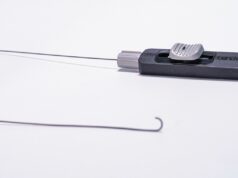
The National Institutes of Health (NIH) National Heart, Lung and Blood Institute has awarded a US$2.8 million grant to support the development of an intravascular steerable robotic guidewire. Jaydev Desai, a professor in the Wallace H Coulter department of Biomedical Engineering at Georgia Tech and Emory University (BME) and director of the Georgia Center for Medical Robotics (GCMR) and his lab are the recipients of the grant.
The NIH ranked Desai’s grant application with its highest degree of confidence, a one percentile score. Commenting on this, Desai says: “That is highly encouraging. It clearly demonstrates how critical and challenging the clinical problem is and why innovative engineering solutions need to be developed to address it.”
The project features the first use of intravascular steerable robotic guidewire capable of forward-looking ultrasound imaging and image-guided navigation through vasculature and occluded vessels.
Quoted on the Georgia Tech website, Desai explains that the ability to steer, visualise, and navigate the guidewire is highly novel and will eventually result in improvement of clinical workflow and patient treatment outcomes. “Think of a plumber’s snake,” he says. “And this is all about steering the tip of the long snake with visualisation of where to go with ultrasound imaging.”
Desai’s collaborators include Brooks Lindsey (Coulter Department), Stanislav Emelianov (Coulter Department and School of Electrical and Computer Engineering), and from Emory, Muralidhar Padala (cardiothoracic surgery), Khusrow Niazi (interventional cardiology) and Zachary Bercu (interventional radiology).
Desai’s team plan to address three specific aims:
- Design and develop a robotically steerable, 0.014-inch diameter guidewire (0.355mm) system to accommodate a 0.350mmx0.350 mm ultrasound transducer at its tip, and can be steered with image feedback from the transducer.
- Design and build a forward-looking transducer for the robotically steerable guidewire and an algorithm to reconstruct an image of the encountered occlusion.
- Iteratively optimise the ultrasound-steerable guidewire design using 3D printed, patient-specific models of chronic total occlusions (CTOs), realistic human cadaver limbs with CTO, and a live animal model of CTOs.
“The clinical challenge is well recognised in the community,” Desai adds. “Since endovascular approaches are increasingly utilised over conventional approaches, there is an urgent need to develop new technologies to meet this critical need!”
The designed system, Desai says, “will have significant societal impact through improved patient outcomes, reduced radiation exposure for the physician and the patient, reduced rate of procedural failures, and lower healthcare costs.”










